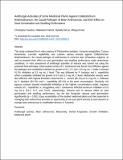| dc.description.abstract | This study evaluated the in vitro potency of Plectranthus barbatus, Vernonia amygdalina, Conyza bonariensis, Leonotis nepetifolia, and Lantana camara extracts against Colletotrichum lindemuthianum, the causal pathogen of anthracnose in common bean (Phaseolus vulgaris), as well as assessed their effect on seed germination and seedling performance under greenhouse conditions. In vitro assessment of antifungal activities of extracts was carried out using the poisoned food technique. Ethyl acetate extract of C. bonariensis was found most effective against the pathogen and completely inhibited its growth at 5.0, 2.5, and 1.25 mg mL-1 while it showed 91.2% inhibition at 0.5 mg mL-1 level. This was followed by P. barbatus and L. nepetifolia which completely inhibited the growth at 5.0 and 2.5 mg mL-1 level. Methanolic extracts were also effective with highest inhibition observed for L. camara (85.1%) at 5.0 mg mL-1, followed by P. barbatus (84.7%) and L. nepetifolia (83.1%) at the same concentration. Similarly, the aqueous extracts showed remarkable inhibition at the highest concentrations tested. Aqueous extracts of L. nepetifolia, V. amygdalina, and C. bonariensis inflicted maximum inhibition at 5.0 mg mL-1 (75.0, 74.7, and 73.3%, respectively). Extracts had no adverse effect on seed germination and seedling performance, but the test fungicide reduced seed germination significantly (p < 0.001). Easy accessibility of the studied medicinal plants and their potential in managing bean anthracnose provides an opportunity to use such plant extracts as seed dressers to manage bean anthracnose in smallholder farmers in Tanzania. | en_US |

